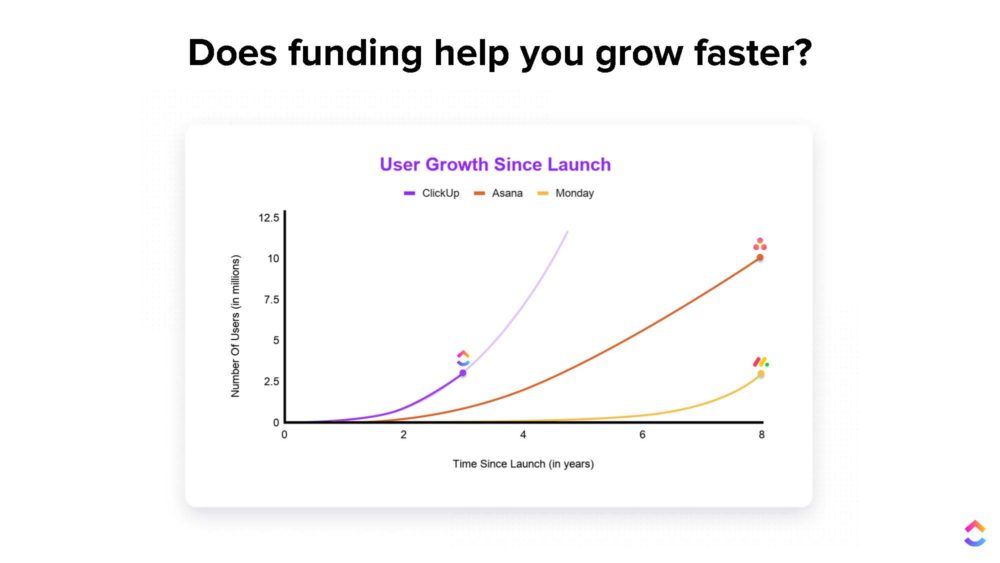I’ve had several near-death experiences in my life, one being my own company.
By all accounts, we were almost screwed.
Imagine entering the most crowded software market in the world.
Why, for god’s sake, would anyone choose to build another productivity app?
It was a dumb decision.
Until it wasn’t.

We defied all market odds and became one of the fastest growing software companies ever, bootstrapping our way to $20M ARR.
And unlike most of today’s startups, we didn’t do it the traditional way:
- We didn’t raise outside funding; we scraped by and grew organically
- We didn’t pick a vertical; we went big and went wide
- We didn’t hire engineers from Google or Facebook; we hired for work ethic and growth potential
Even if we knew how to get VC money (we didn’t), no one would fund our vision anyways.
But it worked. And it can work for you as well.
Here are three things I learned from bootstrapping a software startup from $0 to $20M ARR.
1. Natural Product-Market Fit creates faster and more sustainable growth than artificial
Everyone talks about Product-Market Fit; it’s the holy grail of SaaS.
But nobody explains the two ways of getting there.
The first is what I call Natural Product-Market Fit. It means product-led growth combined with virality and organic marketing methods.
The second is the more popular route for startups: Artificial Product-Market Fit. Execs and investors make loads of cash, you generate tons of PR overnight, and you eat up market share by literally purchasing users.
There’s a catch though: most companies that go artificial pump their VC windfall into sales and marketing; not R&D to build a better product.
At ClickUp, we did the opposite.
What’s more, we learned you can grow faster going the natural route to Product-Market Fit.

Not only did we grow faster than our competition, we also achieved Product Market Fit in less time and without throwing millions of dollars into ad campaigns and sales teams.
Natural Product-Market Fit is the only way you can achieve PMF without spending money on sales and marketing.
Okay, but what’s the secret path to NPMF?
How does bootstrap David beat VC-backed Goliath?
It starts with listening to the most important people in the world: your organic users.
2. Pair actionable feedback from organic users with your vision
Your first users are not only your most loyal and passionate, they’re also your sounding board for what’s working and what’s not.
You need to build a cyclical relationship with your customers; an authentic feedback loop that brings your product closer to NPMF. And it all starts with organic users.
Win organic users
Winning (not buying) your first legion of fans requires growing organically.
Here’s how you find them (or lead them to finding you):
- Helpful content (yes, content is still king)
- SEO
- Message boards and communities (Quora, Reddit, etc.)

Our blogs not only help visitors with problems they’re trying to solve, they also position us as an alternative to the status quo.
Actively helping in niche groups on social platforms helped build our first communities, grass-roots style.
We first started creating value content over two years ago. Today, that free content nets ClickUp $12M in free clicks every month.
The returns were slow at first; organic is a long game. But if you’re consistent and patient, you’ll attract organic users. And organic users are your best users — they snowball in ways that paid users can’t.
Listen to user feedback
Once you’ve won over organic users, you need to listen to them. Contrary to popular belief, users do know what they want.
We used Canny to gather user feedback, organize it, and act on it. There are many platforms out there to help you do this.

But nothing beats talking to your users in-person or on Zoom. Open that feedback loop, get in front of your customers, and develop that real connection.
Organic feedback is the special sauce for building your product, trust, and authenticity, it should also help inform your product backlog (not all of it, but you get the idea.)
Listening and delivering to your fanbase creates a feedback loop; it helps your product, makes you stand out, and creates communities that will serve you for years to come.
Combine user feedback with your vision
The intersection between user feedback and your vision is where you begin to find NPMF.

Let me be clear: you can’t let your users define your vision for you. They aren’t creating your product. You are.
You must stick to your vision or you’ll end up being another carbon copy of what exists already. When feedback aligns with your grand vision, you’ve hit a sweet spot for reaching Natural Product-Market Fit.
That’s when you can pair actionable feedback with your product vision.
So what do you do once you have actionable feedback that aligns with your product vision?
You SHIP IT! And ship it really freaking fast.
3. Iterate and ship fast like your life depends on it (it does)
Shipping fast matters more than anything.
Delivering on features, requests, and bug fixes is what creates a viral loop and makes your customers your best advertisers.
Choose progress over perfection
We’ve launched a new release every Friday for the last two years. It’s a speed and consistency that none of our competitors can keep up with.
Is it always perfect? Of course not.

What matters most is progress over perfection. It’s one of our core values at ClickUp.
We choose to ship fast knowing we will improve it with the help of our users. This high frequency compounds over time, getting us closer to perfect at a faster rate than our competition.
How to ship really fast
Here are six (somewhat controversial) approaches we take to ship faster than our competition.
1. Tech debt is B.S. (early on)
Hear me out: there is no example of a company with Product Market Fit that couldn’t scale. There are graveyards, however, of SaaS companies that failed to ship fast enough. If you have PMF, you always have room to figure it out and fix things later.
2. Separate HTML and CSS roles
People programming in Javascript should not be writing HTML and CSS.
They shouldn’t be making your product pixel-perfect. This little change will make everyone on your team happy.
It’s a win-win for your engineers and will save you lots of time.
3. Don’t write automated tests (early on)
When you’re changing things quickly on the front end, the reality is you’re going to spend a lot of time breaking and then fixing tests while not actually breaking your product.
There is a ton of overhead that goes into maintaining those tests. Save it.
4. 5x engineers
Everybody talks about 10x engineers.
Stop looking for these unicorns. Look for 5x engineers, there are more of them.
If they can do a week’s worth of work in a day, hire them.
5. Work-life imbalance
This one isn’t politically correct but it’s the key to creating a nimble company that moves faster than your competition.
We only hire people who are obsessed with what they do and love solving problems.
If your entire company works 10% harder than the rest of the market, that will compound and help you beat your competitors in the long run.
6. Users will forgive you
Very minor bugs are okay. Product imperfections are okay.
We say “ship it and see what happens.”
It’s been part of our core philosophy since day one and ties back to progress over perfection.
If you do all of these things, you can ship weekly.
Create a Natural Product-Market Fit flywheel
Combine everything together and you get a flywheel that no amount of VC money can buy.
This flywheel transformed my vision (that should’ve been dead in the water) into the fastest growing software in our industry today.

Now, say it with me:
- Win free, organic users
- Listen to feedback to improve your product
- Combine that with your vision
- Ship as fast as possible
…and boom. You will have created this obsessed fanbase of active users and advocates for your product.
Or, you can go the artificial route:
- Get a ton of money
- Spend it as fast as possible on sales and marketing
Do they both work? Absolutely.
But only one allowed ClickUp to grow faster and win over 2 million high-quality users for free, in the most competitive software market in the world.
This blog post is brought to you by ClickUp.


